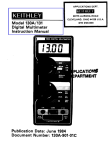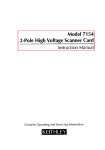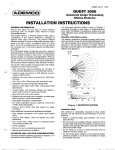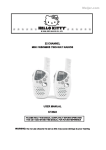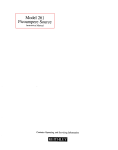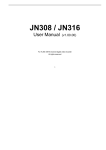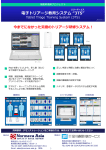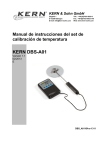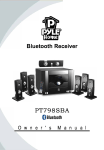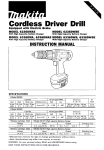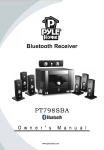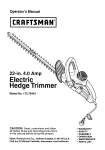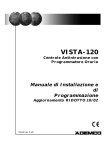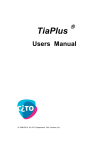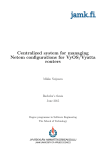Download Keithley -
Transcript
Model 7056 General PurposeScannerCard Instruction Contains Operating and Servicing Information Document Number: Manual 7056-901-01 Rev. D WARRANTY Keithley Instruments, workmanship Keithley Instruments, shipment: During Inc. warranty this product to be free from defects in tnatcrial and for a period of I year from date of shipment. Inc. warrants the following probes, cables, rechargeable the warranty items for 90 days from the date of batteries, diskettes, and documentation. period, we will, at our option, either repair or replace any product that proves to be defective. To exercise Keithley return this warranty, headquarters instructions. facility. write or call your local Keithley in Cleveland, Ohio. You will Send the product, representative, be given prompt transportation prepaid, to the indicated Repairs will be made and the product returned, transportation or replaced products are warranted or contact assistance and for the balance of the original service prepaid. Repaired warranty period, or at least 90 days. LIMITATION OF WARRANTY This warranty Keitbley’s does not apply to defects resulting express written does not apply to fuses, software, non-rechargeable age, or problems OR FITNESS SHALL MENTS OF ALL KEITHLEY BE LIABLE AND SUCH EXCLUDED without DAMAGES DAMAGES COSTS OF REMOVAL AND RESULT OF INJURY TO ANY INC. NOR INDIRECT, OUT IF KBITHLEY OF THE SHALL OR PROVIDED HEREIN REMEDIES, ARISING EVEN IN ADVANCE EXPRESSED OF MERCHANTABILITY USE. THE REMEDIES DIRECT, also instructions. WARRANTIES, WARRANTY INSTRUMENTS, FOR ANY SOFTWARE ADVISED OTHER IMPLIED SOLE AND EXCLUSIVE CONSEQUENTIAL BEEN ANY FOR A PARTICULAR ARE BUYER’S NEITHER IS IN LIEU INCLUDING modification batteries, damage from battery leak- arising from normal wear or failure to follow THIS WARRANTY IMPLIED, from product consent, or misuse of any product or part. This warranty ANY OF THE INCIDENTAL OR USE OF ITS INSTRU- INSTRUMENTS, POSSIBILITY INCLUDE, OF ITS EMPLOYEES SPECIAL, OF SUCH INC., BUT ARE NOT LIMITED INSTALLATION, LOSSES SUSTAINED PERSON, OR DAMAGE TO PROPERTY. HAS DAMAGES. TO: AS THE Model 7056 General Purpose Scanner Card Instruction Manual 01992, Kcithlcy Instruments, Inc. All rights reserved. Cleveland, January Document Ohio, 1992, Number: U.S.A. First Printing 7056-901-01 Ilcv. D Safety Precautions The following safety precautioos ciated instrumcntatioo. with nowhazardous should be obsewed before using this product and any asno- Although some inrtromeots This product is intended for use by qualified familiar with tbc safety pnxaotions formation and accessories woold nonnally bo used voltages, there arc situations wberc hazardous conditions may be present. carefully personnel who rccogoiu: rcqoircd shock hazards and are to avoid possible injuly. Read lbe operating it]- before using the product. ‘The types of product users arc: Kesponsiblc body equipment, is tbe iodividunl or group responsible for ensuring tlnt the equipment for the USCsod owinleoaoce ia operated within ing limits, and for ensuring that operators are adequately Operators use the product for its intended function. its spccilications of and operat- trained. Tbey most be trained in electrical safety procedures and proper use of the iostrument. ‘lhey most be protected from electric shock and ~onmt with hazardous live circuits. Maintenance personnel perform mutioe procedures oo the product to keep it operadog, for example, setting the hoc voltage or replacing consumable materials. Maintenance am dcacribed in the manual. The procedures explicitly Othcrwisc, they should be performed Service personnel proccdurcs state if the operator ~nay perform them. only by senice pcnonoel. are trained to work on live circuits, sod perfoonn safe installations pairs of products. Ooly properly trained setvice personocl may perform installation sod reand scr- vice procedures. Exercise extreme caution whco a shock hazard is present. Lethal voltage may be present on cable coonector jacks or test fixtures. 111~ American National Standards lostitute (ANSI) stam that a shock hazard exists wheo voltage levels greater than 30V RMS, 42.4V peak, or 60VDC are present. A good safety practice in any unknown circuit is to expect that hazardous voltage is present before measuring. Users of this product must be protected fmm electric shock at all timer. The responsible body must eosum thtat wets aw pwented a.cce~saod/orinsulatcd from every connection point. lo some cases, conoectiuns most be exposed to potential buman cootact. Product usa io these circuo- stances must be trained to protect themselves from the risk of electric shock. If the circuit is capable of operating at or abovc 1wO volts, no conductive AY described in the Ioteroational ital multimcter Electratechnical measuring circuits (e.g., Keifhley 2010) are Installation part of the circuit may be exposed. Commission Models Category II. All other instruments (IEC) Standard IEC 664, dig- 175A, 199, 2OOQ,2COl, 2002, and signal tennioals are Installation Cat- egory I and must oat be conoected to mains. Do not conoect switching cards directly to unlimited used with impedance limited sources. NEVER Wheo conoccting sources to switching power circuits. They are inlendcd to bc connect switching cards. iostall protective cards directly to AC mains. devices to limit fault current sod voltage to tbc card. Before operating ao instrument, make sure the line cord is connected to a properly grounded power receptacle. Inspect the connecting cables, test leads, and jumpers for possible wear, cracks, or breaks bcforc each oso. For maximum safety, do not touch the product, test cables, or any other instrumcots while pow- er is applied to the circuit under test. ALWAYS dischuge soy capxitors remove power from the entire test system sod before: coooccting or disconnecting cables or jumpers, installing 01 removing switching cards. or making iotemtil chaogcs, socb as installing or nzmoviog jumpers. Vu not touch soy object that could provide a con-cot path to tbc common side of the circuit under test or power line (eatth) ground. Always make measurements witb dry hands while standing oo a dly, insulated surface capable of withstanding The instrument tbc voltage bciog measured. and accessories most be used in accordance with its specifications eratiog iostructioos or tbe safety of the equipment Do not exceed the maximum tbe speciticationr signal levels of the instruments sod operatiog panels, or switcbiog information, and op- may be impaired. and es show and accessories. as defined in on the instrument or test fixture cant. When fores are used in a product, replace with same type sod rntiog forcootioued pmtectioo against fire hazard. Cbassir connections must only be used as shield coooectioos for me~suriog circoits, NOT as safety eaflh ground connections. If you are using II test fixture, keep the lid closed while power is applied to the device under test. Safe operation requires tbe we of a lid interlock. 1ra@ screw is present, connect it to safety earth ground uaiog the wire recommended in the user documentation. The ! symbol on an iostroment n stmctions located io tbc manual. The h indicates that the user should refer to the operating ill- symbol on al iostmment shows that it CNI source or IIICRIIUII: loo0 volts or more, ill- eluding the combined etTect of normal ad common mode voltages. Use stiuldarrl safety precaulions to avoid pcrsooal cootect with these voltages. TIE WARNING beading in A manual enplaios dangers that might result in personal injury or death. Always read the associated information wy carefully hcfore ptxformiog the indicated pC"CCdU~C. The CAUTION beading in a manual explains hazards that could damage the instrument. Such damage may invalidate the warrmty. lostrumcntatioo and accessories shall not be connected to humans. Before performing To maintain pmtcctioo coils, including Keithley any maintenance, disconnect the line cord and all test cables. from electric shock and ftre, replacement the power transfouner, Instruments. that are not safety r&ted chased from other suppliers as long as they are equivalent to tbe original that selected parts should be purchased only through Keithley racy sod fonctiooality of the product.) call a Keithlcy To clean an instrument. of the instrument in mains cir- Standard fuses, with applicable national safety appmvals, may be used if the ratiog sod type are the same. Other components ment component, components test leads, and ioput jacks, must he purchased from Iostmmcnts (Note to maiotain acco- If you we unsure about the applicability Instruments may hc por- component. of a replacc- office for information. use a damp cloth or mild, water based cleaner. Clean the exterior only. Do not apply cleaner directly enter or spill on the instrument. tb the instrument or allow liquids to Products that consist of a circuit hoard with no case or cbas- sis (e.g., data acquisition board for installation ing if handled according to instructiuns. into a computer) should neverrequire If the board becomes contaminated is affected. the hoard should he returned to the factory clean- sod operation for proper cleaninglserviciog. tie”. 2rB SPECIFICATIONS 7056 GENERAL PURPOSE SCANNER CARD CHANNELS PER CARD: IO in 2-pole mode, 20 in I-pole mode. CONTACT CONFIGURATION: 2- le Form A, includes Model 7055 Quick LXs~omeCt Card. HI or LO switch ecr to a eerlerete outout for l-m& mode, common . . . guard connection CONNECTOR TYFE: Screw temina,, No. 18 AWG ma.ximum wire size. Tem,i,,a,s mounted on 7055 quick dtscok potion of 7056. RELAY DRIVE CURRENT: 24mA per relay typical. MAXIMUM SIGNALsLEVEL: 150”. 25hA, IOV.$ peak (resistive load). CCl,“JT LIFE: 10 dosures (cold switching); 10 ciosores (at maximum signal CONTACT RESISTANCE: cZI2 to rated life. CONTACT POTENTIAL: <lC@V per contact pair input to output with copper leads (c5OpV typical). ACNATtON TIME: <2ms, exclusive of mainframe. CHANNEL ISOLATION: >lOgQ, OOpF typical; MdB into 500 @ I-. INPUT ISOLATION: Differential: >lOgP and <50pF typical. Common Mode: >lOgQ and 45OpF typical. COMMON MODE VOLTAGE: <,50” peak. ENVIRONMENT: operating: 0’ to MT, up to 3sT at 70% RH. storage -WC to WC. DIMENSIONS, WEIGHT: 32mm high x 114mm wide x 272mm long K25 in. x 4.5 in. x 10.75 in.). Net weight 027kg (9.5 oz.). Spedfications subject to change without notice. NOTE BecauseofhighimpedanceoftheboardsSedalcareshouldbetakeninboth handling and using the board to prevent egradatmn of prfomence. Handle the board by the edges when win it and kee it free of body oils, dirt and contaminants. To dean the board use distill e% water an % a dean cotton swab or soft brush Thoroughly saub the beard and then remove all water residue with dry nitrogen gas. After the board is dean bake for five hours at 54°C and low relative humidity. TABLE OF CONTENTS 1.1 1.2 1.3 SECTION l-GENERAL INFORMATION Introduction ............................................ Warrann/ Information .................................... ManualAddenda ........................................ 2.1 2.2 2.3 SECTION Z-OPERATION lntraduction ............................................ Wiring and Installation. ................................... Operating Considerations ................................. 3 3 5 3.1 3.2 3.3 SECTION 3--SERVICING INFORMATION Introduction ............................................ Required Test Equipment ................................. Performance Verification .................................. 7 7 7 4.1 4.2 4.3 4.4 4.5 SECTION 4-REPLACEABLE PARTS Introduction ............................................ ReplaceablePans ........................................ Ordering Information ..................................... FactoryService .......................................... Component Layout and Schematic Diagram 13 13 13 13 13 ................. LIST OF FIGURES 1 2 3 4 5 6 7 a 9 10 11 Typical Channel, Voltage Scanner Mode .................... Typical2by5Matrix .................................... Channel Numbering-l-Pole .............................. Thermal Offset Test ...................................... Model 7056 Timing Test in Model 705. ...................... Model7056 Isolation Test in Model 705 ..................... Differential Input Isolation ................................. Channel Isolation ........................................ ................. Model7055, Component Location Drawing. ................. Model 7056, Component Location Drawing. .......... General Purpose Scanner Card, Schematic Diagram 3 4 6 a 9 10 11 12 15 16 17 LIST OF TABLES 1 2 3 Recommended Test Equipment ............................ Model 7055 Replaceable Parts List .......................... Model 7056 Replaceable Parts List .......................... 7 14 14 SECTION 1 GENERAL INFORMATION 1.1 INTRODUCTION The Model 7056 is e general purpose relay ecenner plug-in card which is fieldinstallable in en appropriate Kelthley ecenner mainframe (e.g. Model 706). The Model 7056 w/II switch up to 10 channels. The card can be used 88 e voltage ecenner. independent relay card or e matrix card. The Z-pole switching 18 eccompllshed in less than 2ms and the expected relay life is lo8 closure8 et the maximum contact ratings. Barrier strips ere used to facilitate input end output connections to the relay ecenner plug-in card. The plug-in card can easily be removed through the rear panel of the ecenner mainframe. The Model 7066 provides the connection to the individual channels via the screw clamp type terminal strips. 1.2 WARRANTY INFORMATION Warranty information is staled on the inside front cover of the manual. If there is e need for service, contact the Keithley representative or authorized repair facility in your area. Check the back cover of this manual for addresses. The service form supplied at the end of the manual should be used to provide the repair facility with adequate informoiion concerning any difficulty. 1.3 MANUAL ADDENDUM Improvements or changes cluded with this manual. to this manual will be explained on en addendum in- 1 SECTION 2 OPERATION 2.1 lNTROOUCTlON This section provides information priate scanner mainframe. 2.2 WIRING AND needed to use the Model 7056 with an sppro. INSTALLATION 1. Wiring Configuration-Each channel on the Model 7066 card consists of 10-Z Form A relays and 2-1 Form A relays for one pole mode. The card ten be wired es e voltage scanner card, independent relay card, or e matrix card. Channel 1, on the component designation. shows the terminal locations which are similar to Channels 1 through 6. Channel 10 shows the terminal locations typical for Channels 5 through 10. A. Voltage Scanner Card-The Model 7056 can be used as a voltage scanner card. Figure 1 shows e wpical channel in the voltage scenner mode. When the Model 7056 card is used in e Model 705 scenner mainframe, one of 10 channels can be switched to the output et 8 time. When ecanning, the relay contract8 of one channel will break before the relay confactS on e second channel will make, ensuring isolation between channels. B. Independent Relay Card-The Model 7066 plug-in card can be used es an independent relay card. The relay switching 18 still controlled by the scanner mainframe. When using the circuit, do not exceed the maximum contact ratings. C. Matrix Card-The Model 7066 ten be used 88 e 1 by 10 or a 2 by 6 matrix card. The Model 7056 should be first set up 88 e voltage scanner card. To use it es e 1 by 10 matrix card, the output HI or output LO can be used to switch to any of the 10 input HIS or input LOS. For “88 88 e 2 by 6 matrix card, refer to Figure 2. This allows the ueer to switch the output HI or output LO to sny of five inputs. Figure 2 shows the 2 by 5 matrix setup. 2. Installation-Refer to the Model 706 Instruction Msnual for installsdon structions. TO OTHER CHANNELS Figure 1. Typical Chennel, Voltage Scanner Mode 3 in- LO OUTPUT HI -iy2 CH.1 CHl LO < CM.2 HI r---t “...” rl k-4 I \ c F”1 -Ii+, ( CM.4 LO I \ c F”C i-i-c”0 ( CH.0 HI CM5 LO WI.7 CH7 LO \ WI.6 F”o. Figure 2. 2 by 6 Matrix HI 2.3 OPERATING CONSIDERP,TIDNS 1. Signal Levels-The signal levels that the Model 7056 operates et are 1OV 115OV maximum~/lOmA 1250mA maximum). The load should only be resistive, and 1OVA is the maximum switching level with a resistive load. The contact life of the relays with normal signal levels is l~closures. At maximum signal levels, the number of closures is degraded by a factor of 10. NOTE Reactances in the system will cause switching transient% during switching. These transients should not exceed the ratings given. If they do, the transients can degrade the relay contact life. 2. External Considerations-The Model 7056 specifications ere for a resistive load; however, external circuit capacitances and inductances ten cow% excessive cur~%nt% and voltages across the relay contacts The currents and voltages must be limited to within the contact ratings. A. Capacitance-Charged capacitances in the circuit ten cease excessive currents isurge current4 to flow through the relay contects, if the SOWC% is shorted out or the output is switched to capacitive loads. This excessive current can weld the relay contacts together. Therefore, use series resistors where needed to limit the maximum current that can flow, to within the contact ratings. For example. a DC power supply specification mey indicate that the output current is limited to lOmA. However, because of internal capacitors connected across the power supply output. high surge currents can easily flow through the relay contacts. If they are shorted or when switched to reactive loads lsuch as the input to % voltmeterl. a surge may result. The surge current can be very high and may only be a few microseconds in duration, but they can still weld the relay contacts together. The currents must be limited to within the contact ratings of the relay. The limits are stated in paragraph 2.3.1. 6. Inductance-The inductance of cables can produce high voltage and arcing across the relay contacts when switching. The peak transients must be limited to within the contact ratings. The limit% 81% stated in paragraph 2.3.1. C. Cables-Shielded cables should be used with the Model 7066 card when switching above 5OV. The shield should be connected to the circuit LO or Guard. This helps prevent excessive rod&ion from the cables from interfering with any equipment. 0. I-Pole Configuration-The Model 705 ten be used in the l-pole configuration by utilizing front panel program number 6 on the Model 705 mainframe. Refer to the Model 705 instruction manuel for information concerning the front panel programs. Generally, the l-pole configuration is used for applications where a user can use % single common ground in the meesurement. The channel numbering for the l-pole configuration ie shown in Figure 3. The l-pole output is taken from the IP connector to ground on the Model 7056. Flgure 3. I-Pole 6 Mode Channel Numbering SECTION 3 SERVICING INFORMATION 3.1 lNTROOUCTlON The following section contains 8 performance procedure. Since there are no calibration adjustments, no recslibrotion is necessary. Recommended maintenance would include inspection of the scanner plug-in board and card edge connector to ensure good electrical contact. 3.2 REQUIRED TEST EQUIPMENT Recommended recommended test equipment is given in Table 1. Test equipment other than may be substituted if specifications equal or exceed the stated characteristics. Table 1. Recommended Minimum Test Equipment Specifications Zero drifi’less than .$N. IV Full Scale Sensitivity TTL compatible square wave to 10Hz. and 1 pulse per 30 minutes. Accessory Triax Cable 3.3 PERFORMANCE Triggered Sweep lOgA Sensitivitv Triaxial with cl(p leads. IOVDd, 1OOVDC II KI TEK KI ! “K; 705 7000 seril 619or61 1 %’ VERIFICATION This section gives the procedures needed to verify that the operation of the Model 7056 is within spocificntions. For the following tests, the Model 7066 should be set up in the voltago scanning mode, NOTE The following test procedure is used for the Model when used in the Model 705 scanner mainframe. 1. Thermal 7066 card Offset Test A. Figure 4 shows the test setup for the ttwmal offset test. The Model 177 should be set to DCV and the 2OmV range. The Model 177 should be allowed to stabilize for two hours. During this time the analog output should be connected to the chart recordor and a recording made to establish a baseline for the voltage measurements. B The 10 input connections on the Model 7056 plug-in card should be shorted together between HI and LO with a length of #14 to #22 AWG solid copper wire, i.e.. 81120 screws should be tied together. With a cable attached to ths output, the plug-in card should then be inserted into the 7 Model 705 mainframe cable from the Model and power applied to the Inainfram? Conn@ct the 7056 outfxn to the input of the Model 177. C. After the warm.up time has elapsed and a stable baseline is visible on the chart recorder. set the Model 705 scanner mainframe’s interval time to 16 minutes. Also set the Model 705 to the Channel mode and the Step mode. Scan each channel at the programmed interval rata (15 minutes). This is accomplished by pressing the START/STOP button on the Model 705 nnce for each channel. Once the START/STOP button is activated for one channel. the Model 705 closes that channel for the programmed interval rate 115 minutes1 then opens that channel and advances to the next channel. To scan the next channel press the START/STOP button. The thermal EMFs generated in each channel will be visible as a deflection from the baseline on the recording. The maximum deflection should be no more than f lOO,U from the baseline for any channel, exclusive of switching spikes. The ambient temperature should be kept at 23OC -t 3% for this test. I MODEL 706/7066 COPPER WIRE SHORTS ON CHANNELS 1 TO 10 Figure 4. Model 7066 Thermal Offset Test In Model 706 2. Relay Contact Timing Test A. The 10 input connections and the output should be shorted together between HI and LO with short pieces of wire, on the Model 7056 card. Do not connect each channel together; just connect the individual HI and LO of each channel. B. Figure 5 shows 8 the equipment setup for this test. Select Channel 1. C. The signal generator should be set 10 B 10Hz squorowave output. The scanner should be selecting the desired channel when the signal generator’s output is a 1 and all off when the generstor is 0. 0. The oscilloscope should be set to trigger on the signal generator’s put. The oscilloscope should be s@ as follows: SWEEP: out- 0.5ms per division. VERTICAL SENSITIVITY: TRIGGER: External 5V per division. E. With the oscilloscope on I + j trigger, the typical time to the first contact la transition from 1OV to OVJ should be 0.3177~ or more. The contacts should settle in less than 2ms. F. Turn the oscilloscope to (-1 trigger. 1OV transition is less than 0.25ms. G. Test all 10 channels as described The typical release time for a 0 to in steps A through F. NOTE A series resistor lR$l must be used with the power The resistor should be 1ktI or larger. supply output HI, SIQNAL QENERATOR HI I LO L IEXTERNAL COM TRIQQER MODEL 706/7066 INPUT HI LO ; 2 OUTPUT HI I.0 - z 1 CHANNEL UNDER TEST HI LO TRIQQER “I INPUT LO OSCILLOSCOPE Figure & Ra - MODEL 230 “’ VOLTAGE SUPPLY Lo 1ov DC 5. Model 7066 Timing Test In Model 706 g 3. Isolation Tests Input Isolation Common Mode A. This test measures the common mode input isolation which resistance between the signal lines and power line ground. the test setup for this test. 8. Short the output HI and LO connections a short piece of wire. C. Set up the test circuit shown together is the leakage Figure 6 shows on the Model 7056 with in Figure 6. 0. Insert the Model 7056 into the mainframe and sit the Model 705 to STEP (see Model 705 Instruction Manualland Channel 1. E. Set the Model 230 for 1OOV DC and set the electrometer F. Program the Model 230 output the ZERO CHECK position. G. Take the reading and manually readings for each channel should calculate the input isolation. R capacitance of the circuit, the capacitance is charged up. Wait MODEL 10 6. Model 7066 out of scan from Channel 1 through 10. be less than 1 x lV7A. Using Ohms = E/I = lOOV/lO-7A = llN1. Due to offset current may be high until until the reading settles out. 706,7058 OUTPUT Figure to lO7A range. to operate and take the electrometer Isolation HI LO Test In Model 706 The Law the the Input 18oletion. Differential (Guarded) A. This test meawre~ the differential input isolation which is the leakage resistance between a guarded channel HI and LO. Set up the test circuit shown in Figure 7. l3. Set the Model 705 to Channel 230 to output 1 end the Step mode. 1OOV. set the electrometer Program the Model to Amps and take it out of zero check. C. Take the reading on the electrometer and manually ?san from Channel 1 through 10. The reading for each channel should be less then 1 x 10-7A. Using Ohms Law calculate the input isolation R=Ell=lOOV/10~A = lL%fl. Due to the capacitance of the circuit, the offset current may be high until the capacitance is charged up. Wait until the readings settle out. Flgure 7. Differential Input Isolation IGuarded) Test Set Up Channel Isolation A. This test measures the channel isolation which is the isolation channels. Set up the circuit shown in Figure 8. i3 Short the HI and LO connections of each channel on the Model between 7066. C. Set the Model 705 to Channel 1 end the Step mode. Program the Model 230 to output 1OOV. set the electrometer to Amps end take it out of Zero Check. Program Channel 1 es open end the other channels es closed. D. Tako the reading on the electrometer and manually scan from Channel 1 through 10. The reading for each set of channels should be less then lo-‘A. Using Ohms Law calculate the channel isolation for each set of channels. R = E/I = lOOV/lO--7A = l@a. Duo to the capacitance of the circuit the offset current may be high until the capacitance of the circuit is chargod up. Wait until the readings settle out. 11 MODEL 706/7066 CHANNEL UNDER OUTPUT HI LO GUARD c%l HI LO I MODEL 230 POWER SUPPLY Figure 8. Channel Isolation Test Set Up 12 SECTION 4 REPLACEABLE PARTS 4.1 INTRODUCTION This eectlon conteln~ replacement ports information, component layout for the Model 7056. 4.2 REPLACEABLE e schematic diagram and e PARTS Porte ore listed alpha-numerically in order of their circuit dealgnstlon. contains ports list information for the Model 7056. 4.3 ORDERING INFORMATION To place en order, or to obtain information concerning tact your Keithley representative or the factory. dresses. When ordering include the following 1, Instrument Model Number 2. Instrument Serial Number 3. Part Description 4. Circuit Description lif applicable~ 5. Keithley Part Number 4.4 FACTORY Table 3 replacement perte, con- See the inside front cover for adinformation: SERVICE If the instrument is to be returned to the factan/ for service, please complete service form which follows this section and return it with the instrument. 4.6 COMPONENT LAYOUT AND SCHEMATIC the DIAGRAM Figure 9 contains e component layout for the Model 7065, and Figure 10 contains the component layout for the Model 7056. A schematic diagram of the General Purpose Scanner Cord is contained in Figure 11. 13 Table 2. Model 7055 Replaceable Paris ClrCUit b3ig. Description Keithley Part No. iooi J1002 HO03 Ji 004 J1005 Handle Rivet Connector Connector Connector Connector Connector FA-119 FA-121 cs-457-l CS-457-2 cs-457-l CS-457.2 CS-457-2 Connector, Male (mates for CS-455) #2-56 x 706 Phillips Pan Head Screw #2-56 Hex Nuts Clamp Assembly, Upper a. Clamp, Upper b. Strip, Rubber Clamp Assembly, Lower a. Clamp, Lower b. Strip Rubber #6-32 x 5/i 6 Phillips Pan Head Screw #6-32x 1 Phillips Pan Head SCI’eW CS-456 PI006 7055-303-l 7055305 26621 7055-306 7055-307 26621 Table 3. Model 7056 Replaceable Parts Circuit Deslg. Description Kelthley Part No. Cl01 Capacitor, IOpF, 25V, Aluminum Electrolytic C-314-10 JlOO6 Connector, Female #B-56 y 7/16 Phillips Pan Head Screw #2-56 Hex Nuts cs-455 KlOlK112 Relay RL-I 30 interconnect Board 7055 14 Figure 9. Model 7099 Component Localon Drawing ,9 18 Figure 10. Model 7066 Component Location Drawing


























